Pest
none known
Family: Scarabaeidae Subfamily: Melolonthinae Genus: Maladera Species: Maladera japonica (Motschulsky, 1860)
none available
Total body length 7.0–10.0 mm (0.28–0.39 in). Body shape oblong-oval, widest posteriorly; convex when viewed laterally. Color dark-brown without iridescent sheen. Clypeusclypeus:
part of the head anterior to the frons; the most anterior portion in dorsal view
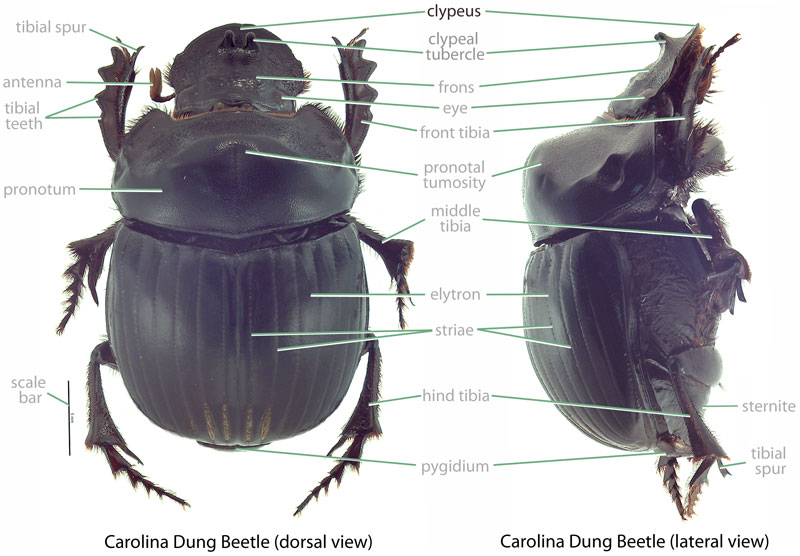 with anterioranterior:
with anterioranterior:
the front or forward; opposite of posterior
margin strongly reflexedreflexed:
margin that curves upward
. AntennaeAntennae:
paired sensory organ on head, formed from numerous segments
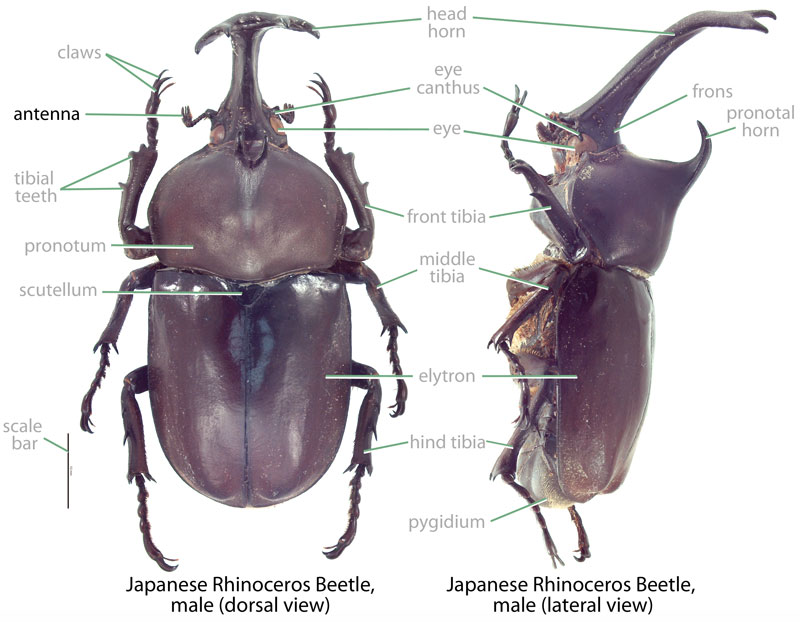 10-segmented; club 3-segmented. Pronotumpronotum:
10-segmented; club 3-segmented. Pronotumpronotum:
the dorsal surface of the thorax
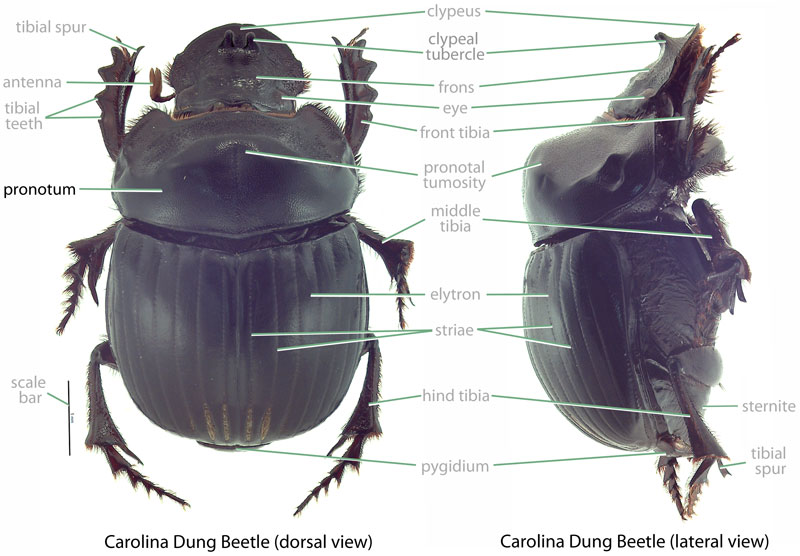 with distinct, moderately deep punctationpunctation:
with distinct, moderately deep punctationpunctation:
relating to a punctate surface texture
. ElytraElytra:
the hardened and chitinous wing-cover of a beetle that protect and overlie the flight wing
lacking obvious setaesetae:
small, hair-like structure
. Male and female lacking obvious characters for separation.
Undescribed in English. For Maladera spp. (Ritcher, 1966Ritcher, 1966:
Ritcher P. 1966. White grubs and their allies: a study of North American scarabaeoid larvae. Oregon State University Monographs, Studies in Entomology 4: 1-219.): Grub C-shaped, not hump-backed, cylindrical, whitish. Cardocardo:
basal (first) segment of the maxilla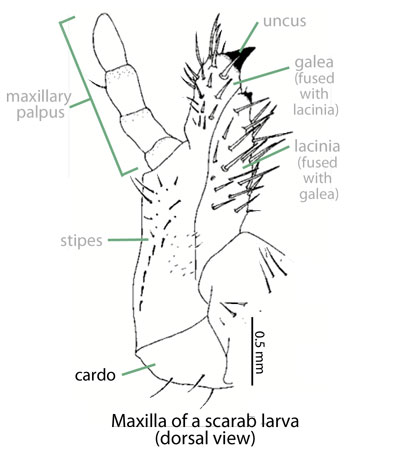 , maxillary articulating membranemaxillary articulating membrane:
, maxillary articulating membranemaxillary articulating membrane:
membrane that covers the region where the maxillae articulates with the head
, and many other body parts with numerous black dots. Galeagalea:
outer branch or lobe of the maxilla
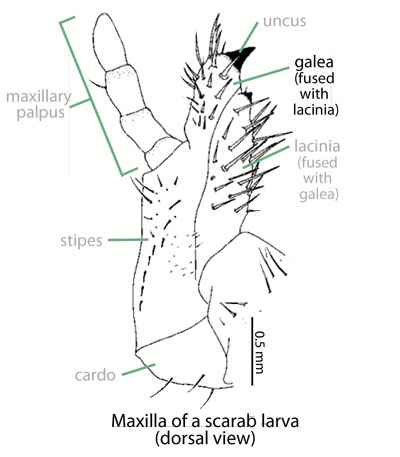 and lacinialacinia:
and lacinialacinia:
inner portion of the maxilla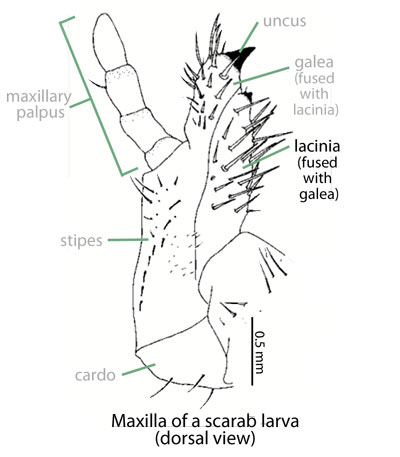 fused proximally, but separated distallydistally:
fused proximally, but separated distallydistally:
situated away from the point of articulation, thus usually furthest from the body
or tightly fitted together. Last antennal segment always with a single, large, oblong, dorsaldorsal:
of or relating to the upper surface; opposite of ventral
, sensory spot. Haptomerumhaptomerum:
in larvae, the medio-anterior (middle of upper) portion of the epipharynx, composed of sensory spots
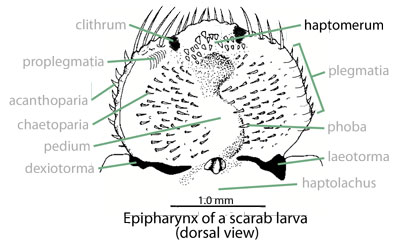 with 3 or 4 heliheli:
with 3 or 4 heliheli:
in scarab larvae, a coarse spine on or near the haptomerum
. Dorsaldorsal:
of or relating to the upper surface; opposite of ventral
anal lobeanal lobe:
fleshy lobe surrounding anus on the last abdominal segment of larvae
much smaller than the ventralventral:
of or relating to the lower surface; opposite of dorsal
anal lobes. Anal lobes densely setosesetose:
covered in setae
. Rasterraster:
in scarab larvae, a complex of setose, spiny, and bare areas on the ventral surface of the last abdominal segment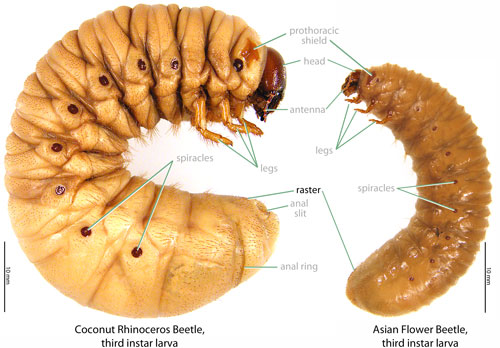 with a curved, transversetransverse:
with a curved, transversetransverse:
extending horizontally across a surface
row of prominent setaesetae:
small, hair-like structure
anterioranterior:
the front or forward; opposite of posterior
to the ventralventral:
of or relating to the lower surface; opposite of dorsal
anal lobes. Anal opening Y-shaped with base of the Y much more elongate than the arms.
Japan. This species is known from Japan (Ahrens, 2007Ahrens, 2007:
Ahrens D. 2007. Taxonomic changes and an updated catalogue for the Palaearctic Sericini (Coleoptera: Scarabaeidae: Melolonthinae). Zootaxa 1504: 1-51. full text (accessed 2015)). Past records from Korea are likely the result of confusion with Maladera orientalis (Kim and Lee, 1997Kim and Lee, 1997:
Kim J, Lee O. 1997. Taxonomy of Korean Sericinae (Coleoptera: Melolonthidae) II, genus Maladera . Insecta Koreana 14: 119-136. full text (HTML) (accessed 2015)).
Host plants for this scarab are poorly recorded. There are records of larvaelarvae:
the immature form of an insect; in scarabs, also called grub or white grub; preceded by the egg stage, followed by the pupal stage
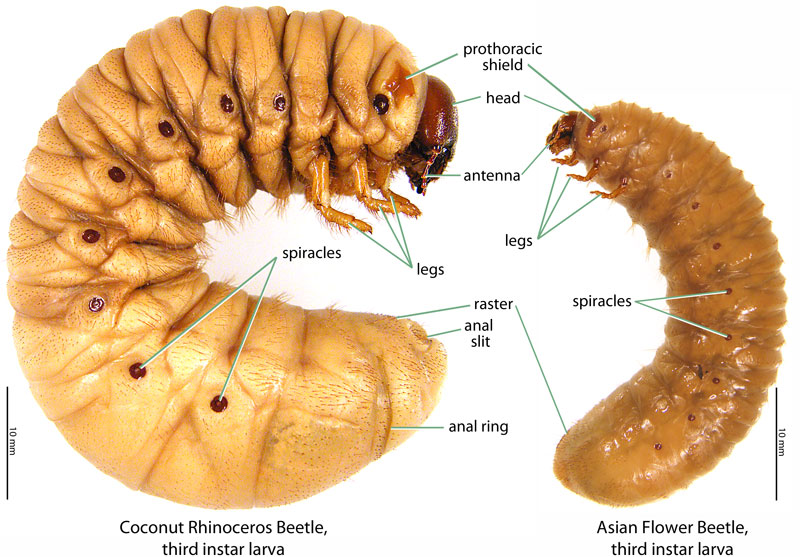 damaging rice (Oryza sativa) (Litsinger et al., 1987Litsinger et al., 1987:
damaging rice (Oryza sativa) (Litsinger et al., 1987Litsinger et al., 1987:
Litsinger J, Barrion A, Soekarna D. 1987. Upland rice insect pests: their ecology, importance, and control. International Rice Research Institute. Manila, Philippines.) and sweet potato (Ipomoea batatas) (Yokoyama et al., 1998Yokoyama et al., 1998:
Yokoyama T, Hasegawa M, Fujiie A, Sawada M, Noguchi K. 1998. Microbial control of scarab beetle larvae by a formulation of Metarhizium anisopliae (Deuteromycotina: Hyphomycetes) in a sweet potato field. Applied Entomology and Zoology 33: 215-218. full text (accessed 2015)). Adults are recorded causing damage to the tung tree (Vernicia fordii) (Sikharulidze, 1975Sikharulidze, 1975:
Sikharulidze A. 1975. Biting pests of tung and their control. Subtropicheskie Kul'tury 5: 71-76.).
Poorly known. The life history of this species is probably similar to that of the closely related Asiatic garden beetle (Maladera castanea). The Asiatic garden beetle (Maladera castanea) is a generalist herbivore both as adult and larvalarva:
the immature form of an insect; in scarabs, also called grub or white grub; preceded by the egg stage, followed by the pupal stage
 . LarvaeLarvae:
. LarvaeLarvae:
the immature form of an insect; in scarabs, also called grub or white grub; preceded by the egg stage, followed by the pupal stage
 develop deep in the soil where they feed on plant roots in moist, shaded, weedy areas (Woodruff and Beck, 1989Woodruff and Beck, 1989:
develop deep in the soil where they feed on plant roots in moist, shaded, weedy areas (Woodruff and Beck, 1989Woodruff and Beck, 1989:
Woodruff R and Beck B. 1989. The scarab beetles of Florida (Coleoptera: Scarabaeidae) part II. The May or June beetles (genus Phyllophaga ). Arthropods of Florida and Neighboring Land Areas 13: 1-223.). Adults are nocturnal, hiding on or near host plants by day (Eckman, 2015Eckman, 2015:
Eckman L. 2015. Host plant feeding preferences of the adult Asiatic garden beetle, Maladera castanea Arrow (Coleoptera: Scarabaeidae). MS thesis, University of Connecticut. full text (accessed 2015)).
Probably minor. There are relatively few records of this scarab causing damage to crop or ornamental plants. However, both adults and larvaelarvae:
the immature form of an insect; in scarabs, also called grub or white grub; preceded by the egg stage, followed by the pupal stage
 are likely generalist herbivores and could potentially cause some degree of damage to a wide range of plant species. Both rice (Litsinger et al., 1987Litsinger et al., 1987:
are likely generalist herbivores and could potentially cause some degree of damage to a wide range of plant species. Both rice (Litsinger et al., 1987Litsinger et al., 1987:
Litsinger J, Barrion A, Soekarna D. 1987. Upland rice insect pests: their ecology, importance, and control. International Rice Research Institute. Manila, Philippines.) and sweet potato (Yokoyama et al., 1998Yokoyama et al., 1998:
Yokoyama T, Hasegawa M, Fujiie A, Sawada M, Noguchi K. 1998. Microbial control of scarab beetle larvae by a formulation of Metarhizium anisopliae (Deuteromycotina: Hyphomycetes) in a sweet potato field. Applied Entomology and Zoology 33: 215-218. full text (accessed 2015)) are recorded hosts.
Recorded, not established. Nishida (2002) recorded this species being intercepted in quarantine. Details of the interception, however, could not be located.
Not established or recorded. There are no records of this species from Guam.
This species probably comes to lights at night, and it is likely that it would be attracted to well-lit ports and airports. This would allow for hitchhiking on marine or air cargo. Further, it is possible that larvaelarvae:
the immature form of an insect; in scarabs, also called grub or white grub; preceded by the egg stage, followed by the pupal stage
 or eggs could be transported in shipments of commercial turf or potted plants.
or eggs could be transported in shipments of commercial turf or potted plants.
This species is very similar to the closely related Maladera castanea. These species can be separated by comparison of the male genitalia, examination of pronotal punctationpunctation:
relating to a punctate surface texture
(M. japonica with punctationpunctation:
relating to a punctate surface texture
moderately deep and distinct versus M. castaneawith punctures shallow and indistinct), and more superficially by color (M. japonica dark brown without an iridescent sheen versus M. castaneaa rusty-brown to orange-brown with an iridescent sheen).
Aserica japonica Motschulsky
Report your observation of this species at our iNaturalist project.